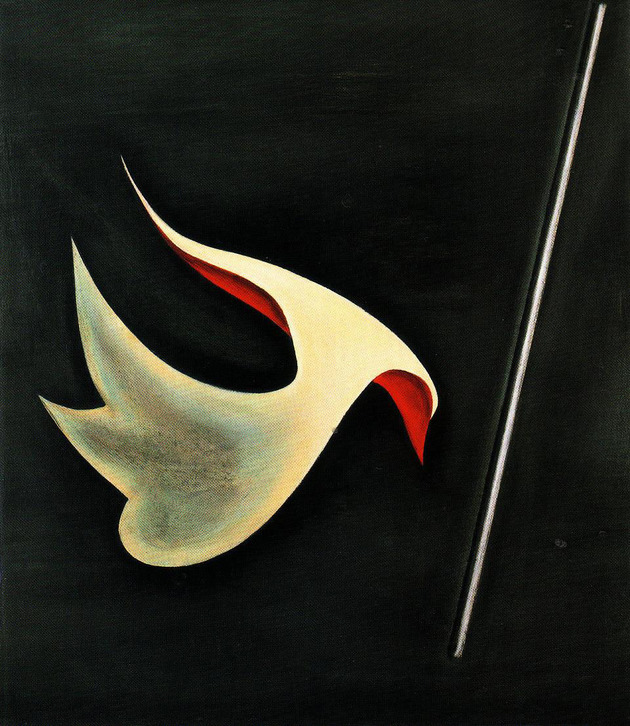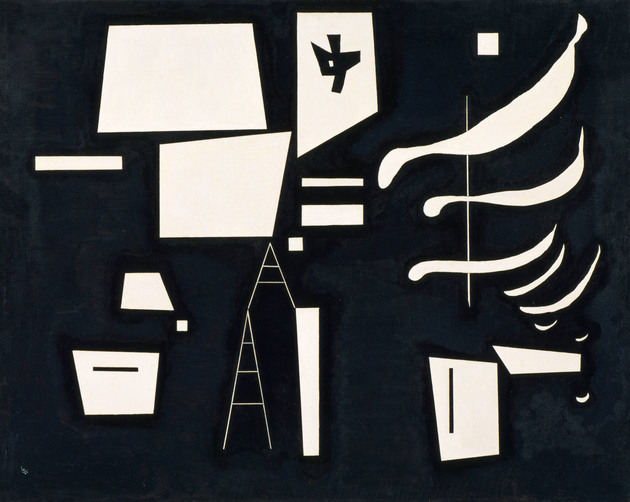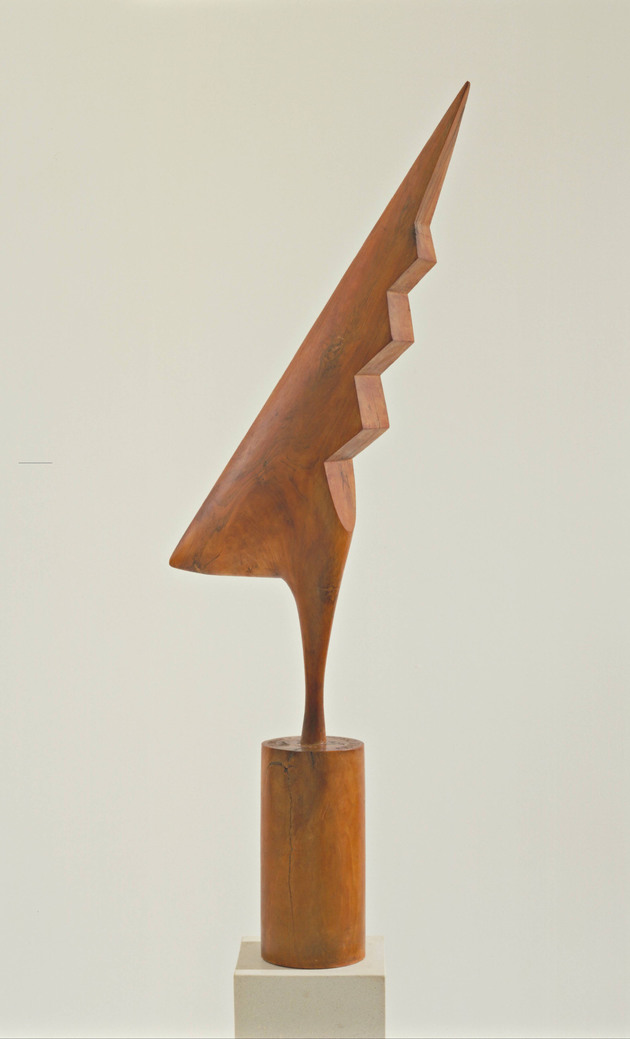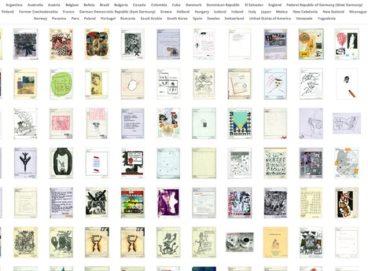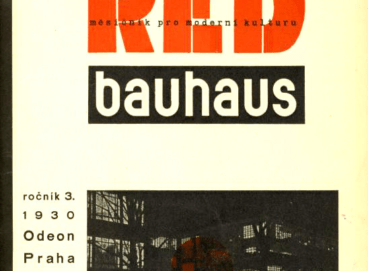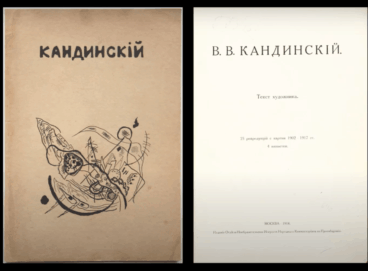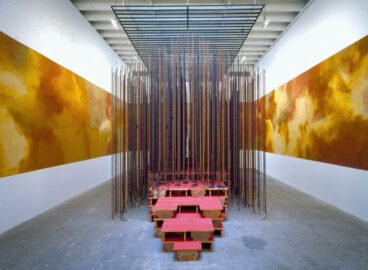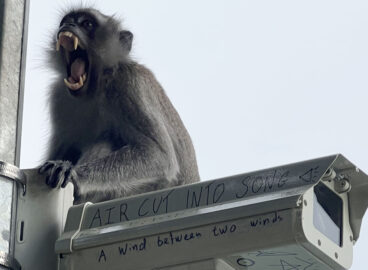In the text “Watashi to jinruigaku: pari daigaku minzoku gakka no koro” (“Anthropology and I: My Time at the University of Paris Department of Ethnology”, 1971) Okamoto Tarō recollects his experiences in Paris between 1929 and 1940, discusses the Abstraction-Création movement and reflects on his time at the Sorbonne and Musée de l’Homme, including his decision to study ethnology as the run-up to World War II intensified, eventually fracturing the international community who gathered in Paris. He describes his development of a theory of the “entire self”—an objective point of origin for identity that becomes clear in a collaborative environment—and how it bears on his theory of the object.
Read the English translation of Okamoto Tarō’s essay here.
In “Watashi to jinruigaku: Pari daigaku minzoku gakka no koro” (“Anthropology and I: My Time at the University of Paris Department of Ethnology,” 1971), the artist Tarō Okamoto (Japanese, 1911–1996) recounts his personal journey through the interdisciplinary, transnational environment of the University of Paris (the Sorbonne).1Okamoto Tarō, “Watashi to jinruigaku: Pari daigaku dinzoku gakka no koro,” in Kikan jinruigaku 2, no. 1 (January 1971): 203–6. Okamoto’s text first appeared in Japanese in the academic journal Kikan jinruigaku (Anthropology Quarterly) in 1971. It is a retrospective consideration of how he developed a mature painterly style and intellectual framework in Paris in 1930–40—as opposed to a manifesto2One example of Okamoto’s manifesto-style writing is “Abangyarudo sengen: Geijutsukan,” Kaizō 30, no. 11 (November 1949): 84–68. For the English translation, see Justin Jesty, trans., “Avant-Garde Manifesto: A View of Art,” in From Postwar to Postmodern: Art in Japan, 1945–1989, Primary Documents, eds. Doryun Chong et al. (New York: The Museum of Modern Art, 2012), 34–38.— and provides one artist’s perspective on how the Sorbonne led to moments of profound connection as well as of isolation for its international participants. Okamoto registers attitudes and anxieties about how categories of identity (“self” and “other” for example) emerge and find expression. Such iterations can produce alternative epistemologies within a “shared social space,” as Weihong Bao argues.3See Weihong Bao, Fiery Cinema: The Emergence of an Affective Medium in China, 1915–1945(Minneapolis: University of Minnesota Press, [2015]), 8. Bao sees cinema as an “affective medium” in Shanghai and interwar Japan, wherein affective radicalisms, aesthetic and political, bump up against mainstream (commercial, narrative) cinema. Affect is key, she argues, to the formation of alternative epistemologies and social perceptions that register anxiety, particularly concerning the power of film media over the viewer. See pages 21–22, in particular. And indeed, for its international participants, the intellectual space of the Sorbonne spurred new interest in living cultural forms that troubled existing categorizations of identity.
Okamoto narrates his progress toward belonging within two interrelated Paris-based communities, often cited in studies of his work and career but little explored in English-language scholarship: those of the Abstraction-Création artists with whom he began exhibiting in 1933, and of the scholars pursuing a Durkheimian mode of “ethnology” practiced by Marcel Mauss (1872–1950), Paul Rivet (1876–1958), and others at the Sorbonne.4The most complete portrait of Okamoto’s activities in Paris can be found in Norio Akasaka, Okamoto Tarō to Pari (Tokyo: Iwanami Shoten, 2008). See also Tsukahara Fumi, “Okamoto Tarō to Maruseru Mōsu: 1930 Nendai Pari to Myuze Do Romu,” in Tōhokugaku 13, no. 2 (Fall 2007): 52–59. This article introduces a Japanese-language readership to ethnology under Marcel Mauss in the 1930s, drawing on his writings as well as on figures like George Bataille and Pierre Klossowski. It shows how Okamoto connected with not only the Musée de l’Homme but also its pendant circles of intellectuals and creatives. This article, however, includes little in the way of Okamoto’s own thoughts on what this time brought to his practice, with the exception of a short mention of his L’esthétique et le sacré (Paris: Seghers, 1976). In English, see Bert Winther-Tamaki, “To Put On A Big Face: The Globalist Stance of Okamoto Tarō’s Tower of the Sun for the Japan World Exposition,” in Review of Japanese Culture and Society 23, Expo ’70 and Japanese Art: Dissonant Voices (December 2011): 81–101. Winther-Tamaki observes the “Picassoid morphology” of the face in Okamoto’s Tower of the Sun for the 1970 Japan World Exposition in Osaka, and suggests that the artist’s interest in primitivist, semiabstract figuration might be traced to his time in Paris, but Winther-Tamaki focuses his analysis on the moment of the World Exposition. Okamoto audited classes on Hegelian aesthetics with Victor Basch (1863–1944) from 1932, and he studied ethnology under Marcel Mauss at the Musée de l’Homme from 1937 before returning to Japan in 1940. During this time, he frequently exhibited at the Salon des Surindépendants, and elsewhere, with his new artist cohort.5See the Okamoto Taro Memorial Museum’s chronology of the artist’s life: http://www.tarookamoto.or.jp/archive/chorology.html
In this essay Okamoto recalls his feelings of isolation as a Japanese artist in Paris, particularly as World War II loomed and his Japanese nationality became a point of tension with his Parisian colleagues. He articulates a frustration with the “sojourn” style of painting practiced by his fellow Japanese expatriates that inscribed them as foreign visitors, and a feeling of “emancipation” from the sojourn mode at finding an intellectual home among the Abstraction-Création artists. Okamoto describes how this association of artists, with their interest in formal relationality, characterized abstraction as an approach rooted in a “globality” (sekaisei), specifically, their shared visual language of abstraction.6Tarō Okamoto, Okamoto Tarō (Toyko: Heibonsha, 2011), 21. Painterly practice began with the “self” and contributed to “movement” or mobilization—of forms, of ideas, outward.7Ibid.
Okamoto’s painting Kūkan (1934/1954; fig. 1) appears in Abstraction-Creation’s 1934 catalogue alongside two works now represented in MoMA’s permanent collection: Vasily Kandinsky’s White—Soft and Hard (March 1932; fig. 2)8See https://www.moma.org/collection/works/80497?classifications=any&datebegin=1930&dateend=1935 and an alternate version of Constantin Brancusi’s The Cock (Paris 1924; fig. 3).9For the version in MoMA’s collection, see https://www.moma.org/collection/works/81692?classifications=any&datebegin=1923&dateend=1925 Okamoto’s abstract forms exist on the edge of representation, much like in Brancusi’s sculpture, which seems to be in a process of anthropomorphic becoming. In Okamoto’s work, the left-hand object appears to drift toward the right-hand one within a dark, vacuum-like ground, suggesting the possibility of their coming together, albeit in a meeting that is imprecise or uneven—much like Kandinsky’s colliding and precariously balanced forms.
In Kūkan, the soft, winglike form seems to be drawn to the dowel-like form—as if by gravity—about to glance off, orbit, or entwine it. This unbalanced duo calls to mind the concept of the informe as expressed by Georges Bataille (1897–1962). For Bataille, the informe is that which denies binary oppositions and instead points to entropic repetition or abrasion. It performs, as Brent Hayes Edwards discusses, a “declassifying process,” or a bending “out of shape” of categories of understanding.10Brent Hayes Edwards, “Review: The Ethnics of Surrealism,” Transition, no. 78 (1998): 84–135. In Bataille’s Surrealist art magazine Documents (1929–1930), the aesthetics of the informe are heavily indebted to the “primitive” bodies and cultural artifacts that were also the subject of ethnological study in the 1930s. For Bataille, their juxtaposition to images from contemporary cinema or Montmartre jazz culture undid the usual opposition of modern to primitive.11Ibid., 115–16, 133–35. Bataille’s project is one that attempts to draw connections between cultures as a means of discussing and understanding human difference. It is not consistently successful at making such connections, however, and the image pairings in Documents have the ability to estrange and isolate the subject embodying difference too. James Clifford discusses what he terms “ethnographic surrealism,” wherein the reading of mundane acts and objects estranges and marginalizes the subject. See Clifford, “On Ethnographic Surrealism,” Comparative Studies in Society and History 23, no. 4 (October 1981): 539–64. Rosalind Krauss describes Bataille’s informe as a method of “deviance” for upsetting “the separations between space and time; . . . the systems of spatial mapping; . . . the qualifications of matter; [and] . . . the structural order of systems. . . .”12Rosalind Krauss, “‘Informe’ without Conclusion,” October 78 (Autumn 1996): 89–105. As Okamoto notes in his essay, Georges Bataille, along with Raymond Aron (1905–1983) and Pierre Klossowski (1905–2001), gathered around the Hegelian philosopher Alexandre Kojève (1902–1968) at the École pratique des haute études in the 1930s.13For more on his lectures at the École pratique des haute études, see Alexandre Kojève, Introduction to the Reading of Hegel: Lectures on the Phenomenology of Spirit, comp. Raymond Queneau, ed. Allan Bloom, trans. James H. Nichols Jr. (Ithaca, NY: Cornell University Press, 1980). In Hegelian terms, their project was one of “reconciliation,” or mediation, of the individual subject to greater and shared goals, and of the modern “now” to histories of community and shared identification.14Regarding Hegel’s understanding of philosophy of “reconciliation” (rechtsphilosophie) as a form of patriotism, see Lydia L. Moland, “History and Patriotism in Hegel’s ‘Rechtsphilosophie,’” History of Political Thought 28, no. 3 (Autumn 2007): 496–519. But this process of reconciliation, as both Okamoto’s painting and Bataille’s Documents explore, also uncovers gaps, inequalities, and those areas that resist falling easily into existing categories of understanding.
Kūkan was exhibited at the Salon des Surindépendants in Paris’s Montparnasse, where Okamoto’s self-expressed aim of emotionality was well received by art critic Pierre Courthion (1902–1988).15For Okamoto’s description of Kūkan, see Okamoto Tarō, OkamotoTarō (Tokyo: Bijutsu Shuppansha, 1968), 8. In his review of Okamoto’s composition, Courthion observes a use of counterpoints to create resonance between objects. He comments that the Japanese expatriate “has a foot on each continent,” but as a painter, possesses “specific Japanese qualities” that allow him to work through the problems of plasticity.16Pierre Courthion, “Okamoto et les Déchirures Sentimentales” (“Okamoto and Sentimental Tears”), in ibid., 184. Ultimately, he draws a connection between Okamoto’s Japanese-ness; his perceived foreignness among his Parisian cohorts; and the appeal of the “refinement, musicality, and rhythm” in his compositions through 1937 to Parisian viewers.17Ibid. In his view, Okamoto’s artwork “resonates” with contemporary Paris while embodying cultural difference.
In a series of memoires published in 1941, shortly after his return to Japan, Okamoto recalls often performing the role of a representative of Japanese “tradition” while in Paris—as he does in Courthion’s essay:18Okamoto Tarō, “Omoide no Pari (ni),” (“Paris of My Memories, Part II”), in Mita bungaku 16, no. 2 (February 1941): 144–49. “Understanding and communicating tradition, I came to feel, was a way of coming to know oneself. When you’re in a foreign country, ‘tradition’ and ‘self’ [jiko] can completely merge in one’s mind. . . . But it’s very dangerous to merge those things even if the latter is often conveyed in/through the former. . . . I came to believe that tradition is my verso [ura].”19Ibid., 144.
Tradition is in a person’s “blood and bones,” he says elsewhere.20Okamoto Tarō, “An Introduction to Tradition” (1955), trans. Maiko Behr, in From Postwar to Postmodern; Art in Japan, 1945–1989, 63. “[T]radition is in our bones,” and yet the “chaos at the root of human nature . . . ultimately transcends comprehension.” In his view “self” sits between inward “tradition” and outward iterations of its significance, or difference as called out by the network or group. We might consider how constructions of racial difference in particular had high stakes in Paris and globally from the time anti-Semitism took center stage in French military justice and national politics during the Dreyfuss Affair (1894–1906). Mauss and his colleagues expressed concern in this period with the potential slippery slope of racial science within academia, the leaking of its judgments into the atmosphere of contemporary society, and the way it textured the rhetoric of colonial campaigns.21See Alice L. Conklin, In the Museum of Man: Race, Anthropology, and Empire in France, 1850–1950 (Ithaca, NY: Cornell University Press, 2013), 59. Conklin discusses how ethnology, or the “science of humanity,” departed from earlier racial (and racist) practices in physical anthropology.
Against this backdrop, the sociology-ethnology contingent at the Sorbonne attracted visual artists, writers, and theorists from diverse national and methodological backgrounds. They formulated interdisciplinary discourses in conversation with Sorbonne-based scholars. Okamoto himself attended Rivet’s seminars at the Sorbonne and participated in curatorial research at the Musée de l’Homme (Museum of Man) in the Trocadero. Through the amassing and curation of collections of specimens (biological and manmade alike) at the Musée de l’Homme, Rivet attempted to bridge the discursive gap between sociology, its new branch discipline of ethnology, and the older race-based physical anthropology.22See ibid. Rivet had trained in “in the field” in South America, in the vein of orthodox physical anthropology forged in such colonial contexts that used biological data—such as cranial measurements—to argue that civilization and cognitive capacity varied according to an observable world hierarchy of “races.” Rivet, however, rejected physical anthropology’s isolation of biological data and instead modeled a more comprehensive approach to the study of so-called primitive world cultures, one that included language, cultural narrative (particularly religion and spirituality), and material culture.
The “primitive” was still a fraught category used by Mauss, Rivet, and other members of their extended circle. But Okamoto observed a developing interest in humanity’s universal, shared lifeforce (seimeiryoku), an understanding that emerged out of conversations regarding the primitive.23Okamoto Tarō, “Ningen no nemoto teki na seimeiryoku” (“Humanity’s Original Lifeforce”), interview by Umesao Tadao in Okamoto Tarō chōsakushū, vol. 9, Tarō tairon (Tokyo: Kodansha, 1980), 328. He recalled in an interview in 1980 that universal lifeforce, or “existence” (sonzai), elucidates commonalities between world cultures.24Ibid., 329. But Okamoto also saw this lifeforce as something intimately tied to national, ethnic, and personal identity—the basis for articulations of Japanese-ness, for example, the “original source” (as he calls it in “Watashi to jinruigaku”) of his own “entire self.” Mauss, whom Okamoto pointed out is the nephew of sociologist Émile Durkheim (1858–1917), viewed ethnology as a new synthesis of ethnographic and linguistic methodologies.25Conklin, In the Museum of Man, 69–70. He approached the science of man from a “social perspective,” informed by Durkheimian sociology’s interest in the “organs” and systems of cultural narrative and social behavior, particularly religion.26See also Marcel Fournier, Marcel Mauss: A Biography, trans. Jane Marie Todd (Princeton, NJ: Princeton University Press, 2015). The “self” in this context is understood within and against cultural systems, institutions, and provisional categories of understanding such as the “primitive.”
As a foreign expatriate and student, Okamoto found himself occasionally slipping between the role of investigator/intellectual/creative producer and subject of inquiry or regard at the Sorbonne—as he does in Courthion’s description above as well.27Anneka Lenssen explores the similar experiences of Syrian artists and intellectuals in Paris such as Kahlil Gibran (1883-1931). See Anneka Lenssen, Lenssen, Beautiful Agitation: Modern Painting and Politics in Syria (Oakland: University of California Press, 2020), 44-79. We might, for instance, consider his description in “Watashi to jinruigaku” of a blood-typing experiment in the classroom Rivet shared with his research partner and wife, Mercedes Andrade (1875–1973). Students were supposed to prick their fingers and draw blood, but Okamoto “mischievously” (chamekki) recounts evading the experiment and simply reporting that his blood type is “C.”28Toshiko Okamoto discusses this anecdote in her biography of Okamoto. See Okamoto, Okamoto Tarō ga, iru (Tokyo: Shinchōsha, 1999), 161-62. She says that while the other students answered “A,” “AB,” “O,” and the like, Okamoto’s answer of “C” was a nonsensical and timely “mischievous… embellishment.” Andrade finds Okamoto’s apparent squeamishness amusing, but Professor Rivet runs home to consult literature on the matter upon hearing of this novel type, Okamoto recounts.29Toshiko Okamoto tells the story a little bit differently. While Andrade seems to immediately understand that he is making a joke, Rivet seems genuinely stumped. He consults his sources to ascertain what region of the world (chiiki) shows a distribution of this blood type. Ibid., 162. It is unclear in this account whether the “C” blood type caused confusion because it defied assumptions about Okamoto’s “type” as someone of a particular cultural or ethnic origin, or for another reason.30Karl Landsteiner (1868 – 1943), a pathologist in Vienna, originally used “A,” “B,” and “C” (instead of “O” with which we are now familiar) to label the human blood types he observed in 1901. Whether it was intended or not, Okamoto’s report of his own blood type was accurate according to this antiquated system and draws attention to the history of blood-type taxonomy. But we nonetheless can observe here a rejection of the system of scientific inquiry on the part of Okamoto when it rendered him the subject of investigation. He also undertook a playful, perhaps critical, engagement with that system’s rules and history of formation at a moment when ethnology itself was still in the process of becoming.31Toshiko Okamoto says that this stunt ensured Okamoto a place in Sorbonne “legend” (densetsu) and made him a memorable personality among his peers. Ibid.
Okamoto observes in “Watashi to jinruigaku” that “art is a deductive rolling-out of an image from an isolated space.” Abstraction-Création provided Okamoto with a space in which his artwork and ideas were able to encounter those of others. Ethnology, then, provided the artist with the critical tools to question subjective judgment. He writes that Abstraction-Création and ethnology functioned as “two mental bearings” that informed his approach to art as well as to his sense of self. We can also observe how Okamoto actively shaped these intertwined spaces of art and intellectual discourse. His artwork elucidates commonalities as well as divergences among the artworks he and his peers exhibited, pointing to a diversity of interpretations and priorities. His voice in the seminar or museum space likewise shaped the group’s mutual understanding of major ideas, particularly when his actions point to the limits and tensions inherent to existing ways of studying culture.
- 1Okamoto Tarō, “Watashi to jinruigaku: Pari daigaku dinzoku gakka no koro,” in Kikan jinruigaku 2, no. 1 (January 1971): 203–6.
- 2One example of Okamoto’s manifesto-style writing is “Abangyarudo sengen: Geijutsukan,” Kaizō 30, no. 11 (November 1949): 84–68. For the English translation, see Justin Jesty, trans., “Avant-Garde Manifesto: A View of Art,” in From Postwar to Postmodern: Art in Japan, 1945–1989, Primary Documents, eds. Doryun Chong et al. (New York: The Museum of Modern Art, 2012), 34–38.
- 3See Weihong Bao, Fiery Cinema: The Emergence of an Affective Medium in China, 1915–1945(Minneapolis: University of Minnesota Press, [2015]), 8. Bao sees cinema as an “affective medium” in Shanghai and interwar Japan, wherein affective radicalisms, aesthetic and political, bump up against mainstream (commercial, narrative) cinema. Affect is key, she argues, to the formation of alternative epistemologies and social perceptions that register anxiety, particularly concerning the power of film media over the viewer. See pages 21–22, in particular.
- 4The most complete portrait of Okamoto’s activities in Paris can be found in Norio Akasaka, Okamoto Tarō to Pari (Tokyo: Iwanami Shoten, 2008). See also Tsukahara Fumi, “Okamoto Tarō to Maruseru Mōsu: 1930 Nendai Pari to Myuze Do Romu,” in Tōhokugaku 13, no. 2 (Fall 2007): 52–59. This article introduces a Japanese-language readership to ethnology under Marcel Mauss in the 1930s, drawing on his writings as well as on figures like George Bataille and Pierre Klossowski. It shows how Okamoto connected with not only the Musée de l’Homme but also its pendant circles of intellectuals and creatives. This article, however, includes little in the way of Okamoto’s own thoughts on what this time brought to his practice, with the exception of a short mention of his L’esthétique et le sacré (Paris: Seghers, 1976). In English, see Bert Winther-Tamaki, “To Put On A Big Face: The Globalist Stance of Okamoto Tarō’s Tower of the Sun for the Japan World Exposition,” in Review of Japanese Culture and Society 23, Expo ’70 and Japanese Art: Dissonant Voices (December 2011): 81–101. Winther-Tamaki observes the “Picassoid morphology” of the face in Okamoto’s Tower of the Sun for the 1970 Japan World Exposition in Osaka, and suggests that the artist’s interest in primitivist, semiabstract figuration might be traced to his time in Paris, but Winther-Tamaki focuses his analysis on the moment of the World Exposition.
- 5See the Okamoto Taro Memorial Museum’s chronology of the artist’s life: http://www.tarookamoto.or.jp/archive/chorology.html
- 6Tarō Okamoto, Okamoto Tarō (Toyko: Heibonsha, 2011), 21.
- 7Ibid.
- 8
- 9For the version in MoMA’s collection, see https://www.moma.org/collection/works/81692?classifications=any&datebegin=1923&dateend=1925
- 10Brent Hayes Edwards, “Review: The Ethnics of Surrealism,” Transition, no. 78 (1998): 84–135.
- 11Ibid., 115–16, 133–35. Bataille’s project is one that attempts to draw connections between cultures as a means of discussing and understanding human difference. It is not consistently successful at making such connections, however, and the image pairings in Documents have the ability to estrange and isolate the subject embodying difference too. James Clifford discusses what he terms “ethnographic surrealism,” wherein the reading of mundane acts and objects estranges and marginalizes the subject. See Clifford, “On Ethnographic Surrealism,” Comparative Studies in Society and History 23, no. 4 (October 1981): 539–64.
- 12Rosalind Krauss, “‘Informe’ without Conclusion,” October 78 (Autumn 1996): 89–105.
- 13For more on his lectures at the École pratique des haute études, see Alexandre Kojève, Introduction to the Reading of Hegel: Lectures on the Phenomenology of Spirit, comp. Raymond Queneau, ed. Allan Bloom, trans. James H. Nichols Jr. (Ithaca, NY: Cornell University Press, 1980).
- 14Regarding Hegel’s understanding of philosophy of “reconciliation” (rechtsphilosophie) as a form of patriotism, see Lydia L. Moland, “History and Patriotism in Hegel’s ‘Rechtsphilosophie,’” History of Political Thought 28, no. 3 (Autumn 2007): 496–519.
- 15For Okamoto’s description of Kūkan, see Okamoto Tarō, OkamotoTarō (Tokyo: Bijutsu Shuppansha, 1968), 8.
- 16Pierre Courthion, “Okamoto et les Déchirures Sentimentales” (“Okamoto and Sentimental Tears”), in ibid., 184.
- 17Ibid.
- 18Okamoto Tarō, “Omoide no Pari (ni),” (“Paris of My Memories, Part II”), in Mita bungaku 16, no. 2 (February 1941): 144–49.
- 19Ibid., 144.
- 20Okamoto Tarō, “An Introduction to Tradition” (1955), trans. Maiko Behr, in From Postwar to Postmodern; Art in Japan, 1945–1989, 63. “[T]radition is in our bones,” and yet the “chaos at the root of human nature . . . ultimately transcends comprehension.”
- 21See Alice L. Conklin, In the Museum of Man: Race, Anthropology, and Empire in France, 1850–1950 (Ithaca, NY: Cornell University Press, 2013), 59. Conklin discusses how ethnology, or the “science of humanity,” departed from earlier racial (and racist) practices in physical anthropology.
- 22See ibid.
- 23Okamoto Tarō, “Ningen no nemoto teki na seimeiryoku” (“Humanity’s Original Lifeforce”), interview by Umesao Tadao in Okamoto Tarō chōsakushū, vol. 9, Tarō tairon (Tokyo: Kodansha, 1980), 328.
- 24Ibid., 329.
- 25Conklin, In the Museum of Man, 69–70.
- 26See also Marcel Fournier, Marcel Mauss: A Biography, trans. Jane Marie Todd (Princeton, NJ: Princeton University Press, 2015).
- 27Anneka Lenssen explores the similar experiences of Syrian artists and intellectuals in Paris such as Kahlil Gibran (1883-1931). See Anneka Lenssen, Lenssen, Beautiful Agitation: Modern Painting and Politics in Syria (Oakland: University of California Press, 2020), 44-79.
- 28Toshiko Okamoto discusses this anecdote in her biography of Okamoto. See Okamoto, Okamoto Tarō ga, iru (Tokyo: Shinchōsha, 1999), 161-62. She says that while the other students answered “A,” “AB,” “O,” and the like, Okamoto’s answer of “C” was a nonsensical and timely “mischievous… embellishment.”
- 29Toshiko Okamoto tells the story a little bit differently. While Andrade seems to immediately understand that he is making a joke, Rivet seems genuinely stumped. He consults his sources to ascertain what region of the world (chiiki) shows a distribution of this blood type. Ibid., 162.
- 30Karl Landsteiner (1868 – 1943), a pathologist in Vienna, originally used “A,” “B,” and “C” (instead of “O” with which we are now familiar) to label the human blood types he observed in 1901. Whether it was intended or not, Okamoto’s report of his own blood type was accurate according to this antiquated system and draws attention to the history of blood-type taxonomy.
- 31Toshiko Okamoto says that this stunt ensured Okamoto a place in Sorbonne “legend” (densetsu) and made him a memorable personality among his peers. Ibid.
